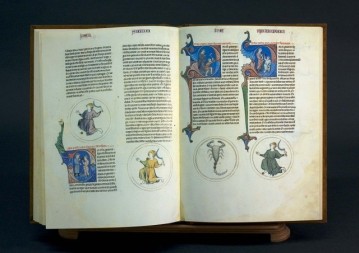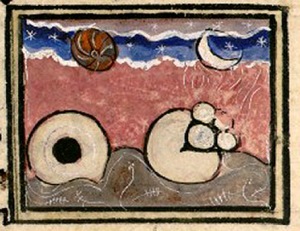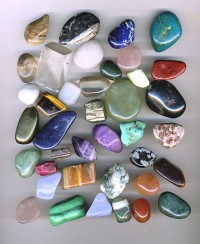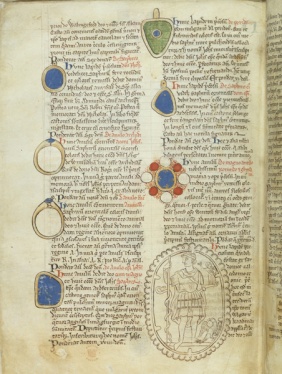By Julie Somers
The medieval lapidary is essentially a book about stones, both precious and semi-precious gems and minerals as well as mythical stones that may never have existed. Closely linked to the bestiary, which has been discussed in previous project blog posts, the medieval lapidary tradition can be traced back to antiquity with the text on Natural History by Roman historian Pliny the Elder (ca. 23-79 CE). Pliny’s account of the properties of various stones and gems, which he categorized by color, durability, and origin, became the basis for knowledge about rocks and minerals throughout the Middle Ages. As legends grew regarding the hidden, magical properties of various gemstones, Christian writers added an allegorical, divine meaning to this system of classification. As such, the pearl is often a seen as a representation of Mary.
Perhaps the most widely distributed medieval lapidary was composed in c.1090 by Marbod of Rennes. His Book of Stones, or Liber lapidum, describes in verse the various qualities of sixty gems and minerals. Marbod listed the medicinal qualities of many stones including diamond, topaz, sapphire or lapis lazuli, and coral. According to Marbod, emerald or smargardus increases wealth, coral protects against lightning or tempests, while diamonds can drive away nightmares and cure insanity.
Another well-known patron of the medieval lapidary tradition was Alfonso X the Wise, King of Castille and Leon (c.1250 – 1284). He influenced the organization of stones according to the signs of the zodiac.

Lapidario del rey D. Alfonso X; codice original. Madrid, Impr. de la Iberia, á cargo de J. Blasco, 1881
PN682.L3 A38 Special Collections oversized
Other works can also be considered lapidaries, though not in the strict sense. For example, Isidore of Seville’s Etymologies discusses the qualities and potential applications of stones such as jasper, while Hildegard of Bingen writes about the medicinal usefulness of stones as healing charms in her work, Physica. The thirteenth-century work by Matthew Paris gives an account of the gemstones held in the abbey of St. Albans. His Liber Additamentorum provides images of the gems in addition to recording their qualities.
The production and use of the medieval lapidary was important to the understanding of the symbolic as well as the natural properties of gems and stones and thus influenced a variety of medieval artistic endeavours. The decoration of prized objects such as Bibles or Gospels with precious gems and stones, as discussed in a previous blog post, represented not only the wealth and piety of the patron, but carried with it many levels of meaning.

Gospel Book (so-called Small Bernward Gospel) Front cover: German (Hildesheim), second half of 12th century. Gilded copper, rock crystal, paint on parchment under horn on oak; Byzantine ivory plaque. Dom-Museum Hildesheim (DS 13) Photograph by Erika Dufour, courtesy of the Art Institute of Chicago.
There are many other lapidaries that support the medieval interest in the symbolism of gems, rocks and minerals, such as the eleventh century Damigeron lapidary, the Nautical lapidary, the German vernacular Das Steinbuch which lists thirty-eight stones, and The Book of Minerals by Albertus Magnus. Large collections of rocks, gems and minerals along with an interest in their natural and hidden properties can be traced to Greek and Roman origins. The medieval lapidary book tradition was a continuation of this interest and a popular resource for making sense of the natural and mystical properties of stones.




